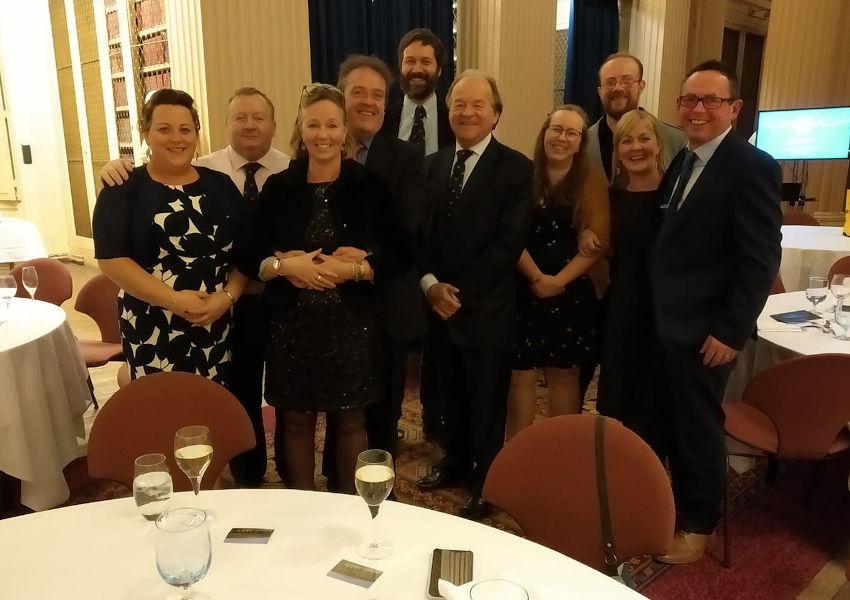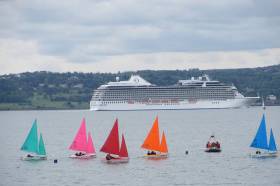Displaying items by tag: Volunteering
Dun Laoghaire RNLI Crew Member Gary Hayes Is Named Christine Buckley Volunteer of the Year
Dun Laoghaire RNLI crew member Gary Hayes has been named the Christine Buckley Volunteer of the Year for 2023.
Hayes picked up the overall honour at the Volunteer Ireland Awards ceremony in Limerick on Saturday night (2 December) after he was nominated by a fellow crew member for his work with both Dun Laoghaire RNLI and Dalkey First Responders.
The Volunteer Ireland awards are the annual initiative to celebrate volunteers in Ireland. The awards shine a light on the remarkable achievements of volunteers around the country by honouring them at a national level. Every year one truly exceptional volunteer is named Christine Buckley Volunteer of the Year in her memory.
Hayes, who works as operations manager at Dun Laoghaire Marina, has been a volunteer at Dun Laoghaire lifeboat station for 21 years — currently serving as a helm and inshore lifeboat mechanic — while he has been a volunteer with Dalkey First Responders for nine years.
His nomination described the crucial role he played in saving lives at sea: “As a helm, Gary operates the lifeboat during dangerous rescue missions, navigating through challenging conditions to reach those in distress. His skills and experience are essential in ensuring the safe and effective execution of rescues. Gary’s commitment and dedication have undoubtedly resulted in countless lives being saved and families being reunited.
 Gary Hayes with his Christine Buckley Volunteer of the Year award trophy | Credit: Alan Hayes/Facebook
Gary Hayes with his Christine Buckley Volunteer of the Year award trophy | Credit: Alan Hayes/Facebook
“Additionally, Gary's role as a community first responder demonstrates his commitment to the welfare of his local community. Community first responders are trained volunteers who provide immediate care to those suffering from medical emergencies before professional help arrives.
“Gary’s willingness to step up in times of crisis and offer his medical expertise helps to bridge the gap between an incident occurring and the arrival of emergency medical services. By providing prompt medical attention, Gary significantly increases the chances of positive outcomes for those in need.
“Furthermore, Gary’s volunteer work directly contributes to building a safer and more resilient community. His involvement in both the RNLI and as a community first responder helps raise awareness about water safety and emergency preparedness. By sharing his experiences and knowledge with others, Gary inspires individuals to become more vigilant around water and encourages them to consider volunteering themselves. This multiplier effect further strengthens the community’s ability to respond swiftly and effectively to emergencies.”
Speaking on being nominated and shortlisted in the Safety and Emergencies category, and then being named the overall winner on the night, Hayes said: “To be nominated for one was a shock. It was a real privilege to be nominated and shortlisted among everyone else who was there on the night and I was definitely not expecting to be announced as the overall winner — everyone else was more than deserving so it was a big surprise.”
RYA Northern Ireland launches ‘We’re All In’ Pilot Scheme to Support Clubs With Volunteer Engagement
RYA Northern Ireland’s new five-year strategy, Navigating the Future, recognises that volunteers are one of the main driving forces behind sailing and boating in Northern Ireland.
Now the organisation has announced a pilot scheme, We’re All In, which aims to reduce the impact of “volunteer burnout” and ensure the long-term sustainability of sailing in NI.
Clubs and centres will be able to apply for a small amount of funding aimed at increasing engagement, either via training of volunteers or holding a volunteer engagement day before the end of April 2024.
In addition to financial support, RYANI says it will work with clubs on a one-to-one basis “as we appreciate that each club is unique”.
Clubs who are part of the scheme will receive direct support from RYA staff about how to reach out to new volunteers most effectively and they will be supported through interactive workshops.
For more details on the pilot scheme, see the RYA website HERE.
RYA Recognises Three of Northern Ireland’s Outstanding Volunteers and Unsung Heroes
Three Northern Ireland sailors have been awarded RYA Volunteer Awards and recognised by Her Royal Highness the Princess Royal, president of the RYA.
The awards, which were held in London, recognise boating's outstanding volunteers and unsung heroes. The Northern Ireland winners were Aidan Pounder of Ballyholme Yacht Club and Thomas Hutcheson of East Antrim Boat Club, who each received a Lifetime Commitment Award, and Debbie Kirkpatrick also of East Antrim BC who received an Outstanding Contribution Award.
In total, 48 RYA Volunteer Awards from across the UK were presented at the annual ceremony. Celebrating both long-standing and younger volunteers, the awards recognise all those who have contributed to the sport and made an impact in their communities.
 Aidan Pounder of Ballyholme Yacht Club receiving his award from Princess Anne | Credit: RYA
Aidan Pounder of Ballyholme Yacht Club receiving his award from Princess Anne | Credit: RYA
The prestigious awards are divided into five categories: RYA Community Awards, Francis Elkin Award, Family Award, Honor Preston Award, and RYA Awards.
Congratulating the winners, RYA Northern Ireland’s chief operating officer Greg Yarnall said: “We were delighted to see three of our very dedicated volunteers from Northern Ireland recognised for their contribution to our sport.
“It’s inspiring to see so many volunteers give up so much of their time to help others and to help develop our sport and we are very thankful for their hard work.”
Prestigious Awards For Volunteering Go To Scottish Lifeboat Stations
Volunteers at Oban and Tobermory’s RNLI lifeboat stations in eastern Scotland have been recognised for their invaluable service in this year’s Excellence in Volunteering Awards.
Oban’s four deputy coxswains — Mark Scott, Finlo Cottier, David Isaac and James Hardie — have all been recognised by the RNLI for their dedication to the station.
The certificates awarded by the RNLI’s chairman and council recorded their “sincere thanks” for “giving time to help provide full time coxswain cover at the station” and for their “commitment and leadership”.
In addition, the Argyll station’s press officers Iain Fulton and Leonie Mead also received awards for their “invaluable support to Oban Lifeboat Station”.
Meanwhile, Tobermory Lifeboat Station — nearby, on the Isle of Mull — received an Excellence in Volunteering Award earlier in the autumn following an operational evaluation carried out by an independent RNLI team of assessors.
The award recognised the crew’s “invaluable service to the institution” and that “with a committed management team and crew fully engaged in all aspects of the station, your focused team efforts, camaraderie and professionalism are greatly appreciated”.
Tobermory lifeboat operations manager Dr Sam Jones also received an award in recognition of her “invaluable service” to the station, of her “outstanding contribution” and for “making a positive impact at the station, engaging the crew and providing safe and effective leadership”.
Full-time coxswain David McHaffie and mechanic Paul Gunn have also received staff awards in recognition of their leadership and dedication at the station.
The RNLI’s prestigious Excellence in Volunteering Awards recognise both staff and volunteers who have gone above and beyond what is expected of them.
Members of both stations attended a celebratory dinner at the Playfair Library in Edinburgh on Saturday 16 November, hosted by the RNLI’s chairman Stuart Popham and Scottish chairman Roger Lockwood.

The dinner rounded off a busy week for Tobermory RNLI. Members of the crew represented the station at the previous weekend’s Remembrance events in Tobermory, including the community commemoration, ‘Mull Remembers’, on Saturday 9 November and Sunday’s service at Tobermory Parish Church and wreath-laying at the war memorial.
Tobermory’s RNLI shop and fundraising branc,h along with some members of the crew, also hosted a mince pie and coffee morning at the Aros Hall on Saturday 16 November. This well-attended annual event took over £600 in shop sales and an incredible £508 from a raffle and donations.
McHaffie said: “The awards to the station recognise the hard work of everyone involved, particularly our volunteers who give up so much of their free time, not only for training and carrying out rescues, but also for helping to make the station run effectively and efficiently.
“I’m pleased that some partners of the crew were also able to attend the celebratory dinner in Edinburgh as we couldn’t operate without the support of our families and friends.”
RYANI Says Volunteers Are Helping To Sustain Sailing & Boating Clubs Across Northern Ireland
More than 960 volunteers are helping to sustain sailing and boating across Northern Ireland each year, according to the RYA Northern Ireland.
In 2017, over 91,000 people took part in a sailing or boating activity.
And with 9,600 club members, volunteers are vital to keeping the sport alive.
Gemma McCoubrey, a volunteer with Belfast Lough Sailability (BLS), finds dedicating her spare time to the organisation rewarding.
“I first got involved through a member of Carrickfergus Sailing Club, who was also a member of Belfast Lough Sailibility. My husband and I had joined the sailing club as we wanted to develop our sailing skills. We spent an evening volunteering with BLS and loved it,” she says.
“Although we had no personal connection regarding disabilities, we were immediately drawn by the immense satisfaction of helping others.”
Gemma explains that her role is to support the overall aim of BLS and to provide access to waterborne activities for people with disabilities.
She says: “The rewards are seeing the smiling faces and hearing the laughter of participants and of being part of that. It is humbling to see just how they overcome extreme challenges.
“In addition to this, I get the opportunity to work with a great team of likeminded people and the craic is great.”
Gemma tells RYANI that she would recommend others to get involved, and she believes they will also see the rewards.
“I love it and always leave a volunteering session with a big grin on my face. I would absolutely encourage others, regardless of their abilities, to volunteer. I believe it is of benefit to both myself and others.
“It is only a few hours of my time each week, but it has a big impact upon people who get a lot of enjoyment from our support.”






























































